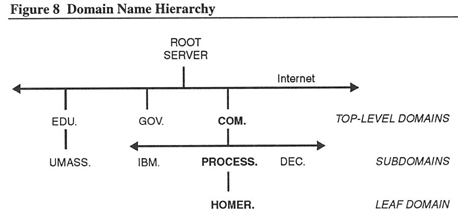TCP/IP Defined - Host Names
Each host on an internet is usually also assigned a unique name. Host names are easier to remember than internet addresses.
Two different host naming conventions are in use today:
- Flat namespace, usually used for small internets
- Domain names, a hierarchical system used by large internets, including the Internet
For any naming convention, you need a way to translate the name into an internet address because of TCP/IP protocol requirements.
Also, there must be an authority for maintaining and issuing names. This authority makes sure that names do not conflict and that they are appropriate.
Flat Namespace
In a flat namespace, each host name consists of a sequence of characters without any further structure. A single authority maintains a table of the host names and assigned internet addresses to avoid naming conflicts and to regulate the names. For the Internet, the Internet Network Information Center (INIC) is the authority.
The mapping between host names and internet addresses is easy for a flat namespace. Typically, each host maintains a file containing a table of internet addresses and the corresponding host names. When an application needs to obtain the internet address for a host name or the host name for an internet address, it scans this file looking for a match.
The main advantage of this naming convention is that names are convenient, flexible, and short. However, a flat namespace has disadvantages for larger networks.
Domain Name System
The Domain Name System (DNS) evolved out of a need to keep track of the host names and internet addresses throughout the Internet. The rapid growth of the Internet created a prohibitive amount of tasks just to maintain a single host table in a central location. Plus, the table became so large that excessive network resources were required to distribute the name and address information to the other hosts throughout the Internet.
DNS solves these problems because it provides a hierarchy for host name administration. It also accurately distributes host name and address information throughout the Internet.
The name space for Internet hosts consists of hierarchically arranged domains. The top-level domains divide the name space into general categories and retain authority over the lower-level ones. This decentralizes name space administration so that administrative issues in one domain do not involve any other. Table 4 lists the top-level domain names.
| Domain Name | Meaning | Example |
|---|---|---|
| COM | Commercial organizations | process.com |
| EDU | Educational institutions | berkeley.edu |
| GOV | Government organizations | nasa.gov |
| MIL | Military organizations | army.mil |
| NET | Network support centers | near.net |
| ORG | Other organizations | eff.org |
| ARPA | ARPANET domain | in-addr.arpa |
| INT | International organizations | nato.it |
| nn | ISO 3166 country abbreviations | au (for Australia) |
You can obtain an updated list of ISO 3166 country abbreviations from several Internet sites. One site is http://www.ccs.neu.edu/.
Each top-level domain is further partitioned into subdomains. The subdomains are delegated authority by the top-level domain to administer their parts of the name space. These subdomains can further delegate authority to lower-level subdomains, and so on.
This might occur in a large organization divided into departments or subdivisions.
Each level of the domain hierarchy has a label. These labels are separated by a dot (.) and together form the domain name. A dot is also required at the end. The domain name is read from left to right, with the left-most label being the lowest domain level, and the right-most label being the top-level domain. Figure 8 illustrates the following domain name example:

In this example, host HOMER resides in the FAMILY.COM domain. FAMILY is a subdomain of the COM domain, and COM is a subdomain of the root domain (. the ending dot). Each subdivision of the domain requires a subdivision of the domain name syntax by the addition of a label that identifies the subdomain.